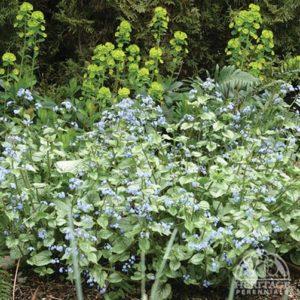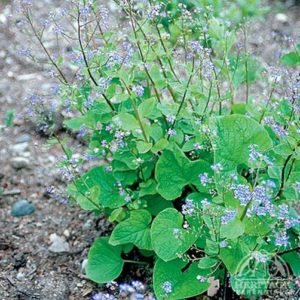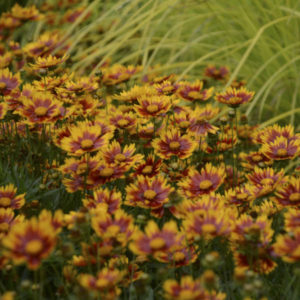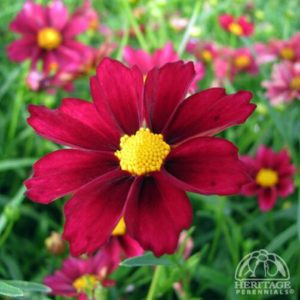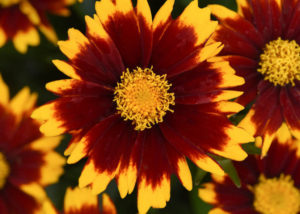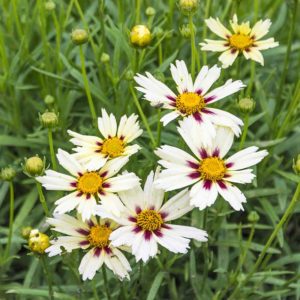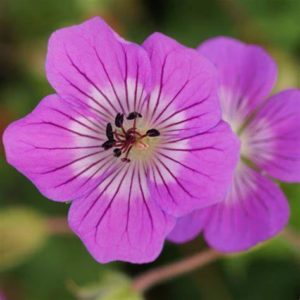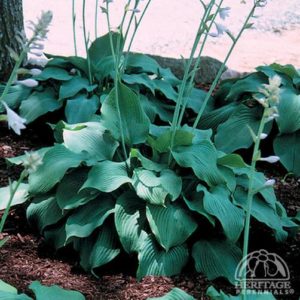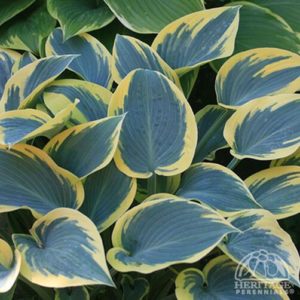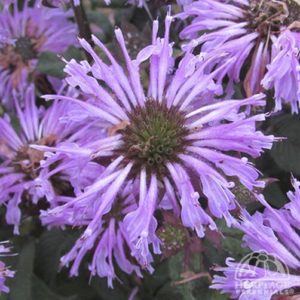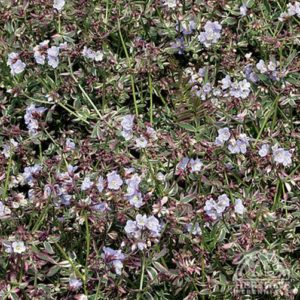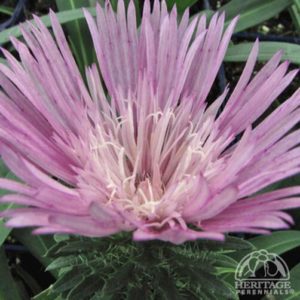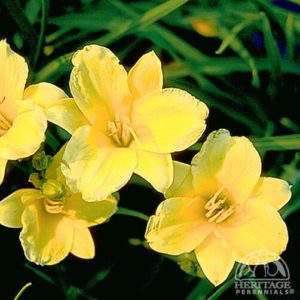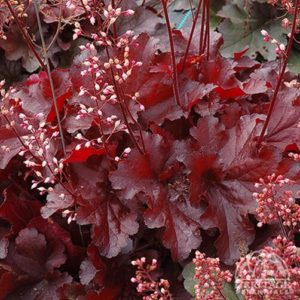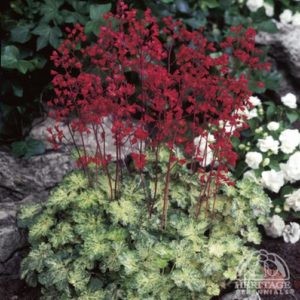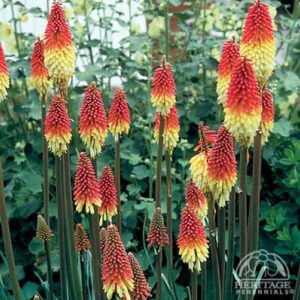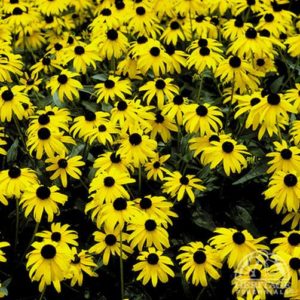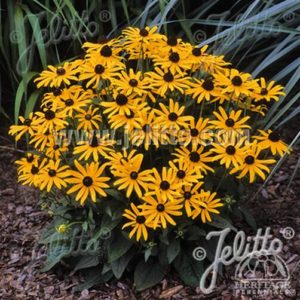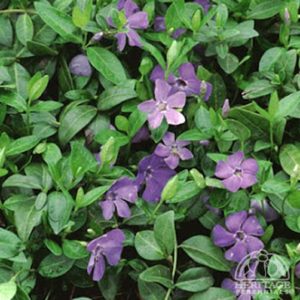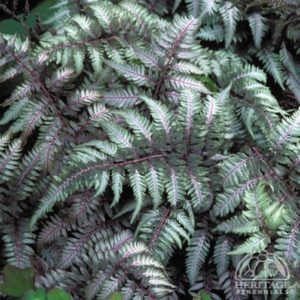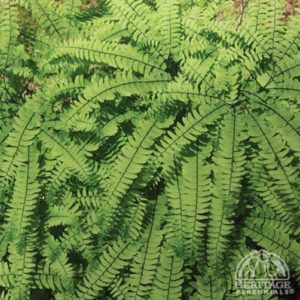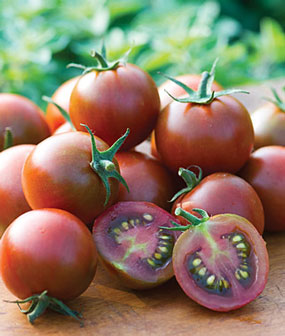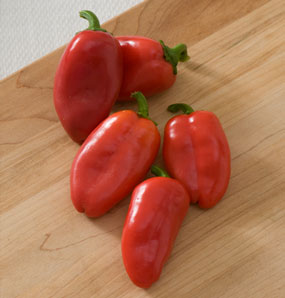Perennials are an excellent to have flowers and foliage that come back year after year. We carry many different varieties of perennials at Schweikert Greenhouse, to make your landscape really shine.
| A superb introduction, forming a clump of heart-shaped silver leaves, delicately veined with mint green. Sprays of bright blue Forget-me-not flowers appear in mid to late spring. This is a choice collector’s plant, but an easy-to-grow perennial that performs well in all but the driest of shady conditions. Excellent for the woodland garden. ‘Jack Frost’ handles more direct sun that most other variegated types of Brunnera, though in hot-summer regions some afternoon shade is recommended to prevent leaf scorch. Chosen as the 2012 Perennial Plant of the Year by The Perennial Plant Association. |
| These cousins to the Forget-me-nots are little-known, yet delightful for their bright display of sky-blue flowers in spring, and reliable clumps of large heart-shaped leaves all season. Plants are happy in any shady area that stays relatively moist. Often will self-seed and appear around the garden in other places. Makes for an attractive and versatile groundcover, particularly under shrubs. Clumps may be easily divided in early fall. |
| A very long-blooming perennial, part of the hybrid Li′l Bang™ series, best suited for sunny areas. It forms a narrow, upright, compact mound of finely-cut, dark green leaves. The exceptionally large, single, red daisy flowers feature a vibrant yellow-orange edge and appear summer to autumn. Well-suited for the front to middle of a sunny border, also good in containers. Excellent disease resistance. Shear mid-season to keep it looking its best all season |
A very long-blooming perennial for sunny areas, forming a low mound of medium-textured leaves. The daisy blooms have wine-red petals, tipped in soft yellow and surrounding an orange button eye. Excellent towards the front or middle of a sunny border, also good in containers. Possibly hardy in Zone 4 or colder, with reliable winter snowcover. One of the Big Bang™ series from American plant breeder Darrell Probst. |
| A very long-blooming perennial for sunny areas, forming a narrow, upright mound of medium-textured leaves. The exceptionally large velvety-wine daisies have a contrasting gold-orange button centre, appearing in succession from mid summer to mid autumn. Some flowers may appear frosted in creamy-white. The flower backs are creamy-white with a purple stripe. Excellent towards the middle of a sunny border, also good in containers. Plants may require some support if grown in very rich garden soil, or simply shear by half in July if they begin to flop open. Possibly hardy in Zone 4 or colder, with reliable winter snowcover. One of the Big Bang™ series from American plant breeder Darrell Probst. |
| Noted for its color variations, Coreopsis UPTICK™ Red (Tickseed) is a compact herbaceous perennial forming a tidy and bushy mound of narrow, mid-green foliage. Blooming continuously from early summer into fall, it produces masses of solid dark red flowers early in the season. The successive blooms are adorned with golden yellow tips. Easy to grow, heat tolerant, and disease resistant, this selection looks great in the garden all summer long. It is perfect for sunny borders and decorative containers. It can even be enjoyed indoors as this Coreopsis makes excellent cut flowers! The UPTICK™ series has won several industry awards. |
| Large white flowers with a burgundy star-shaped eyes attract butterflies for months. Part of the Li’l Bang™ series from master hybridizer Darrell Probst, this compact plant is disease resistant and highly disease resistant—and deer tend to avoid. |
| Geranium Kelly-Anne has bright pink flowers with a darker pink vein. The flowering power is similar to Rozanne’s and the flowering period is very long: from late spring to the first frost. Partly because of this long flowering period, Kelly-Anne is valuable for biodiversity. Kelly-Anne forms a neat, compact plant and is well resistant to diseases, heat and moisture. Plant Kelly-Anne in full sun or semi-shade in a moist, well-drained soil. This Geranium is a beautiful addition in the perennial border and in the rock garden. Also very suitable for mass planting or for a pot on balcony or terrace. Kelly-Anne requires little maintenance. |
| Hosta are among the most popular of perennials for shady areas, with hundreds of varieties now readily available. Plants form a sturdy mound of foliage, topped with lily-like blooms. This huge specimen selection has big, heart-shaped blue-grey leaves and tall stems of near-white flowers in midsummer. Also good for planting in mixed containers or tubs. Hosta go completely dormant in the fall, and the dying foliage can be removed any time before mid spring. Easily divided in either spring or fall, but plants may be left alone for years. Good slug resistance. Elegans group. While deer enjoy eating Hosta, this variety may be slightly less palatable to deer than others. |
| Hosta are among the most popular of perennials for shady areas, with hundreds of varieties now readily available. Plants form sturdy mounds of foliage, topped with lily-like blooms. This midsized selection has thick, powdery blue-green leaves with creamy-yellow margins that later fade to white. Pale lavender flowers appear in August. Thick substance, so good slug resistance. Suitable for planting in mixed containers and tubs. Hosta go completely dormant in the fall, and the dying foliage can be removed any time before mid spring. Easily divided in either spring or fall. While deer enjoy eating Hosta, this variety may be slightly less palatable to deer than others. A sport of H. ‘Halcyon’, this is one of the best selections for late-season interest in the garden. Selected as the 2010 Hosta of the Year by the American Hosta Growers Association. |
| Beebalm is a traditional favourite for the perennial border, with a striking display of richly coloured flowers through the summer months. This midsized selection from the SUGAR BUZZ™ Series has shaggy, lavender-blue flowers. The foliage smells like mint when crushed. Displays above average resistance to powdery mildew. The more compact stature makes this useful in containers or tubs. A favourite of both butterflies and hummingbirds. Beebalm spreads quickly: reduce clump size in early spring. Garden selections all have been bred from native North American wildflower species. Flowers are edible. |
| Simply the best variegated Jacob’s Ladder ever introduced. This forms a low mound of medium-green ferny leaves, each leaflet strongly edged in creamy white and flushed with pink during cooler spring weather. Clusters of lightly fragrant violet-blue bells rise taller in mid to late spring. New fresh leaves continue to appear all season, keeping this variety looking good from spring through late fall. Ideal for edging a shady border or growing beside a woodland path. Appreciates average to moist soil conditions. Afternoon shade is recommended in warm summer regions. Trim back the flower stems as soon as blooming is finished. |
Stokes’ Aster is a North American native wildflower that is a wonderful addition to the sunny border. This compact selection produces large, shaggy flowers that open white and then age to deep mauve purple, for a multicolour effect. It forms a low mound of leathery green leaves, remaining evergreen in mild winter areas. Tolerant of hot, humid summer regions. Great for cutting, and also attractive to butterflies. This needs good drainage, particularly in the winter, so a raised bed might suit it well. Also a good candidate for mixed containers. Remove faded flowers to encourage more buds to form. |
| This is by far the most popular Daylily selection of all time, because it performs so well in all zones, flowering for months on end. Forms a dense clump of grassy green foliage, with upright stems of fragrant, golden-yellow trumpet flowers. Early. Repeat bloomer. Compact habit. Excellent for massing, edging, borders or in mixed containers and tubs. Plants do not usually require dividing for several years, but are easily split apart in fall or early spring. Spent flower stems can be trimmed back after flowers are finished. Remove old foliage in late fall. Award winning. |
| This Coral Bells selection from the FOREVER™ series is a terrific choice for adding a touch of colour towards the front of a border. The cut, softly ruffled leaves are considered the reddest ever. The best red colour will be in cooler temperatures spring and fall. Spikes of small, white flowers appear in mid summer. Vigorous grower. Excellent in mixed containers. Remove any winter-burned leaves in the spring, otherwise no pruning is required. |
| A variegated form of the old-fashioned style Coral Bells, this is attractive both for its flowers and foliage. It forms a mound of rounded green leaves that are heavily splashed in creamy white, with taller stems holding showy sprays of bright-red flowers appear in early summer. Flowers are attractive to butterflies and hummingbirds. Remove spent bloom stems once the flowers fade. Protect from hot afternoon sun. |
| Also known as Red-hot-Poker, these are easy to grow in the garden so long as the soil is well-drained, particularly in winter. Plants form a big clump of grassy leaves that remain evergreen in milder regions. This mixture produces large bottlebrush heads in a range of shades, including yellow, orange and flame red. Stems are wonderful for cutting. Drought tolerant, once established. Clumps may be divided every 3 to 4 years, in the spring. Attractive to hummingbirds. |
| No sunny border would seem complete without the familiar presence of Shasta Daisies. This selection from the Real series features large, double flowers with fringed petals in cream to yellow surrounding a gold centre. Blooms age well and are carried on very strong stems. Very floriferous with improved disease resistance. Excellent in tubs or mixed containers. Flowers are ideal for cutting. Divide plants every 2 to 3 years in spring, to maintain vigour. Removing faded flowers regularly will greatly increase the blooming time. Attractive to butterflies. |
| Among the best border perennials available, this is a selection of one of our native North American wildflowers. Plants make a bushy, upright clump with a profuse display of brown-eyed, golden-orange daisies from midsummer through the fall. Seedheads have good winter interest. A terrific choice for mass planting, combining especially well with ornamental grasses. Excellent for cutting. Removing faded flowers regularly will greatly increase the blooming time. Plants may be easily divided in early spring. Attractive to butterflies. A former Perennial Plant of the Year in 1999. |
| This introduction from Jelitto Seeds is thought to be an improvement over ‘Goldsturm’, an industry favourite for years. It is much more proportional and compact, standing just knee-high. It offers more blooms on a tighter habit and is excellent for containers as well as the sunny border. Loads of yellow daisy-like flowers surrounding a prominent brown cone that in winter, provide a healthy snack for birds. Flowers are great for fresh or dried floral bouquets and are very attractive to butterflies and bees in the summer. Pairs well with all summer bloomers. |
| Also known as Myrtle, and an extremely popular evergreen groundcover. This selection forms a dense mat of glossy dark green leaves, studded with bright-blue flowers in spring. Very shade tolerant, the leaves will sometimes scorch in too much sun. Tolerates dry shade once plants are established. Stems root into the ground readily, and the new plants that form may be easily moved to a new location in spring or early fall. Mowing the patch low after blooming every couple of years will help to keep it thick. Plant 4 to 10 plants per square yard. This is the classic form, popular in gardens everywhere. |
| One of the easiest and most rewarding hardy ferns, this delightful selection performs well in any rich, evenly moist soil. It forms a compact clump of fronds, dark green in colour, overlaid in olive and silvery-pewter, with contrasting burgundy stems. Terrific for edging the shade border, in the rock garden, on in mixed containers. Deciduous. Leaves may be trimmed to the ground in late fall or early spring. Plants are easily divided in spring, every 3 to 4 years. |
| Maidenhair fern has a delicate appearance, forming a medium sized mound of arching black-stemmed fronds with light green leaflets arranged in a wide fan. Excellent foliage for using in cut flower arrangements. Plants take a couple of years to reach mature size, appreciating a rich soil that stays evenly moist. |
